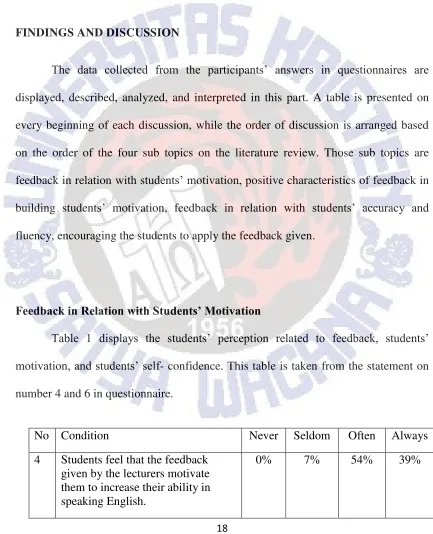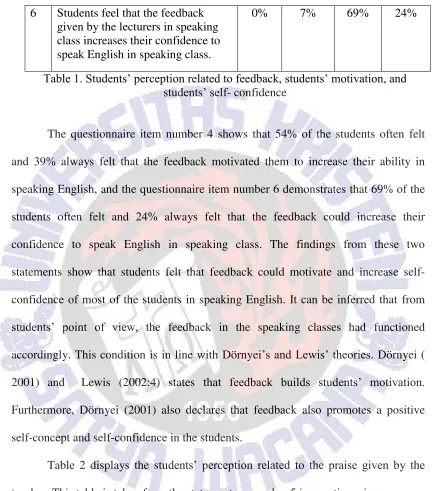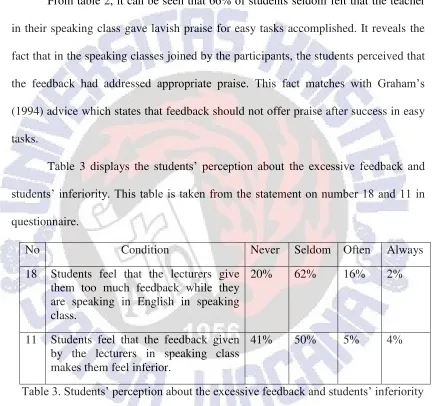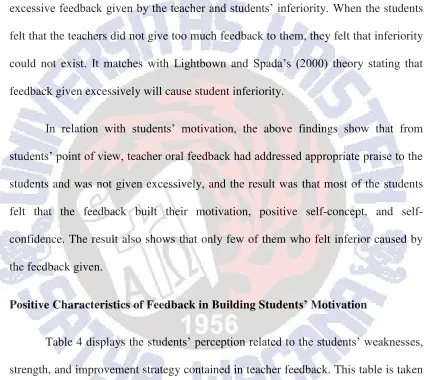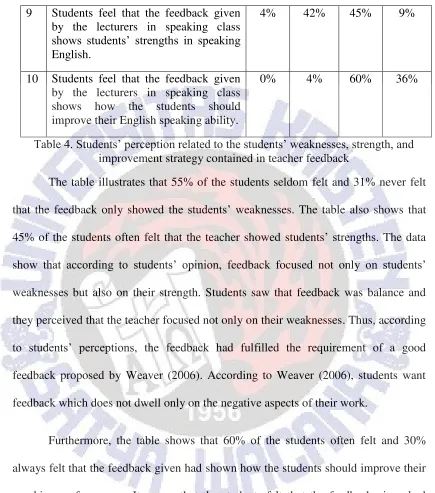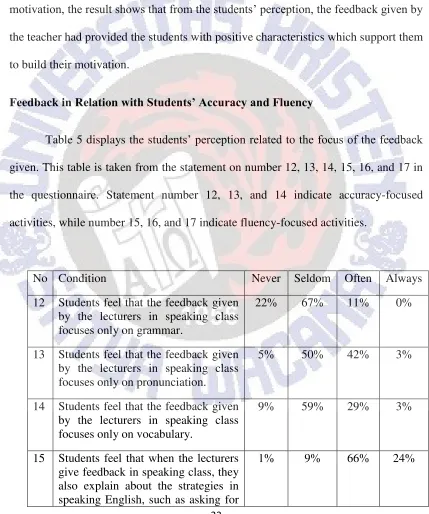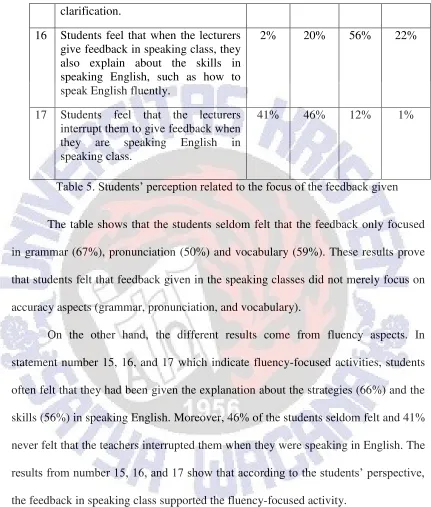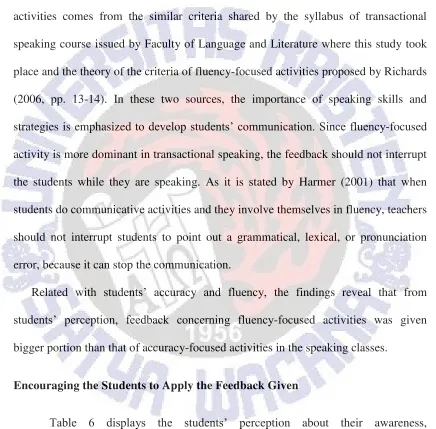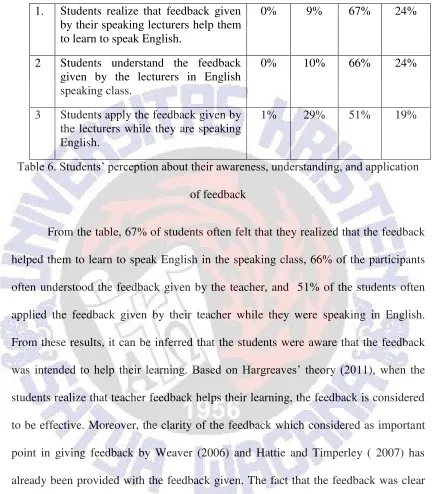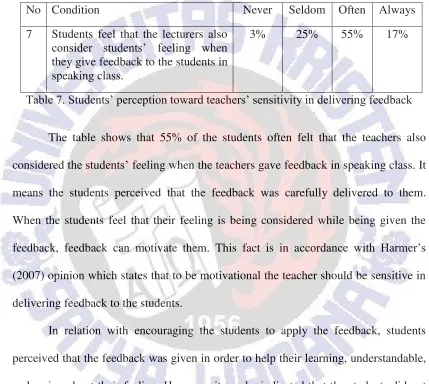6 INTRODUCTION
Joining speaking classes, as a student, I experienced a feeling that some of teacher oral feedback caused me some drawback. At that time, instead of improving my speaking skills, I thought that the given feedback lowered my motivation. I felt that the feedback was not clear and often too much focus on my weaknesses. As a result, I rarely put teacher feedback into my considerations, although I did want to improve my speaking performance. My unfortunate experiences show that my perception toward teacher feedback has influenced the way I respond to feedback.
Those experiences lead me to the curiosity whether the other students also share the same experiences with me, the negative feeling caused by how I perceive the way used by my teachers in giving the feedback and the content of it. In this case, students perception is crucial because it affect the way students react toward the feedback given. Students‟ perception is an important part in learning process. According to Cook (1994: 90), perception guides people‟s behavior. More broadly,
Kreitner (1992: 126) states that perception will also lead to the change of attitude, motivation, and behavior. From those two experts, it is clear that students‟ perception
7
perception because they may risk themselves of continually using counterproductive strategies if they do not understand how students feel about and respond to teacher feedback. Stiggins (2007) adds that students‟ emotional response is a determinant factor of success in learning.
Oral feedback, according to Annie (2011), is the feedback provided verbally by teachers to students as the consequences of students‟ performance, revealing their
competence in speaking such as pronunciation and delivery, communication strategies, vocabulary and language patterns, and ideas and organization. Oral feedback in speaking class is chosen as the focus of this study because of several reasons. Firstly, oral feedback offers direct (face-to-face) interactions between teachers and students, which more or less involve students‟ feeling. The next reason
is that oral feedback mostly happens more in speaking class than any other classes. The third reason is that in second language learning, speaking ability is considered as a very crucial skill, therefore it usually causes students‟ anxiety. In fact, many
students feel that speaking in target language arouses their worry and nervousness.
Since the problems aroused are due to the fact that feedback affects perception, this paper is aimed to investigate the students‟ perception toward teacher
oral feedback in speaking class. Therefore, four determining factors related to students‟ perception toward teacher oral feedback are used as the framework in this
8
relation with students‟ accuracy and fluency, and encouraging students to apply the
feedback. There are four research questions of this study: how are students‟ perceptions toward teacher oral feedback in speaking class in relation with their motivation?; how are students‟ perceptions toward teacher oral feedback in speaking class in relation with positive characteristics of feedback in building their motivation?; how are students‟ perceptions toward teacher oral feedback in speaking class in relation with their accuracy and fluency?; and how are students‟ perceptions toward teacher oral feedback in speaking class in relation in with the students‟ encouragement in applying the feedback?. The result of this investigation will create teacher awareness of students‟ perceptions toward the use of oral feedback.
Feedback in Relation with Students’ Motivation
There is a strong and unavoidable connection between teacher oral feedback and students‟ motivation, and some theories are presented in line with this fact.
Some experts believe that feedback builds students‟ motivation (Dörnyei,
2001; Lewis, 2002:4). From motivational point of view, Dörnyei (2001) mentions that feedback increases learners‟ satisfaction and learning spirit which he calls as “gratifying function” of feedback. Gratifying function occurs when feedback which
9
an indication of the lower expectations held by others for their own level of achievement.
Apart from increasing satisfaction and learning spirit, Dörnyei (2001), from motivational perspective declares that feedback also promotes a positive self-concept and self-confidence in the students. Students‟ positive self-concept and self-confidence arouse when the teacher feedback communicates trust and encouragement. Raffini (1993: 147) states that when teachers believe in students, students believe in themselves. Started with this statement, it can be inferred that when the students believe that the teachers trust them and they find that teacher feedback encourages them to improve their performance, students will be sure about their ability.
10
Positive Characteristics of Feedback in Building Students’ Motivation
Several characteristics of feedback in promoting students‟ motivation are
proposed by some experts. Dörnyei (2001) suggests that in order to build the motivational feedback, teachers should promote “information feedback” instead of “controlling feedback”. Unlike the controlling feedback which gives judgments
against external standards or peer achievements, positive information feedback reflects constructively on the areas needed to be improved by the students and identifies things that the students can do to increase the effectiveness of learning.
Positive information feedback involves positive, descriptive feedback regarding student strength, achievements, progress, and attitudes (Dörnyei, 2001). Moreover, Dörnyei (2001) illustrate the characteristics of positive information feedback. Those characteristics are noting positive or negative trends, identifying areas that were proper and areas that the students should focus on to improve their progress, and providing information on how successfully the learners were applying various strategies and how their strategy was improving their performance.
Also, to increase students‟ motivation, feedback should be balanced. It means
that the feedback should not only focus on negative or positive area of students‟ performance. Related to this statement, Weaver (2006) discovers that feedback which does not dwell only on the negative aspects of students‟ work is more preferable for
11
Moreover, it also needs to be considered that feedback should be constructive (Davidson, 2007; Hong Kong Examination and Assessment Authority, 2009a). The constructive actions can be executed by the teacher by pointing the area the students need to improve. Accordingly, Littlewood (1981) and Lewis (2002) state that teacher feedback should tell students about their progress and show them their errors in order to guide them to areas for improvement. It means that the teacher feedback should give notification to the students which area they have already performed well and which areas that need improving.
Feedback in Relation with Students’ Accuracy and Fluency
12
communication strategies, producing unpredictable language, and seeking to link language use to context. Both accuracy and fluency need to be mastered by students in order to successfully speak the target language.
In connection with feedback, feedback helps to improve learners‟ accuracy
and fluency (Freiermuth, 1998:7). Teachers‟ feedback notes students‟ strong points to strengthen as well as the weak points to improve in accuracy and fluency they perform. The ways of giving feedback in accuracy-focused activities are different with those of fluency-focused. Rahimi& Dastjerdi (2012) suggest that if the focus of the lesson is on accuracy, students‟ errors should be corrected immediately. On the other hand, if fluency is the focus, gentle and delayed correction techniques are applied in order not to damage the flow of the activity or the learners‟ confidence. Harmer (2001) also states that teachers should not interrupt students to point out a grammatical, lexical, or pronunciation error when students do communicative activities and they involve themselves in fluency because it can stop the communication.
13
Encouraging the Students to Apply the Feedback Given
One of the objectives of giving feedback to the students is for students to apply it in order to improve their performance. According to Lewis (2002), feedback can encourage students not only to study but also to use language to the best of their ability by following the teacher‟s suggestions. However, sometimes some students
tend to disregard the feedback given instead of taking it into consideration.
In order to avoid students‟ reluctance to apply the feedback given, several
aspects in delivering feedback to the students need to be considered. Firstly, feedback should be understandable by making it clear. One of the feedback‟s functions is to
14
clear enough, the students will be successful in applying suggestions without wasting time or energy.
Secondly, students have to be given an understanding that feedback is given to them to accommodate their learning. Hargreaves (2011) states that teacher feedback is considered to be effective when the students realize that the feedback is intended to help their learning. Some students may produce various points of view about feedback if the teachers do not clearly state the purpose of giving feedback which sometimes are in the forms of criticism and revealing weaknesses. Harmer (2007) also adds that it is the teacher‟s responsibility to make students aware that feedback is a crucial part of the learning process. It is the teacher‟s duty to find the
best and appropriate way in making the students realize about the role of feedback in their learning process.
15 THE STUDY
Context of the Study
The context of this research was nine (9) Transactional Speaking classes in Faculty of Language and Literature, Satya Wacana Christian University (Central Java, Indonesia), available in Semester II Academic Year 2013-2014. Two study programs in Faculty of Language and Literature (English Teacher Education and English Language and Literature) provide Transactional Speaking with similar syllabus. Transactional Speaking attempts to bring students‟ speaking skills to a higher level where the students are familiarized to the use of language communicatively in a wider range of topics, language functions, and language skills. Activities will include pairs and group discussions, individual and group presentations. The objectives of Transactional Speaking class are developing students‟ communication skills using topics related to daily life, building confidence and develop students‟ oral presentation skills through presentations, supporting
16 Participants of the Study
A purposive sampling technique is used in this study. The participants of this study were 100 students (77 English Teacher Education students and 23 English Language and Literature students) from nine (9) groups of Transactional Speaking classes. Those students were chosen because they had experienced of having teacher oral feedback in the speaking class.
Instrument of Data Collection
In this study the writer used close-ended questionnaires using Lickert scale. The options provided were Never (N), Seldom (S), Often (O), and Always (A). Four determining factors which had been mentioned earlier in this paper are transferred into the questionnaire. This questionnaire contained 18 statements eliciting students‟ perceptions toward teacher oral feedback in speaking class. The statements number 4, 5, 6, 11, and 18 talked about the first determining factor (feedback in relation with students‟ motivation); statements number 8 until 10 discussed about the second
17 Procedure of Data Collection
After the questionnaires for the students were ready, the writer piloted those questionnaires to the participants which had similar criteria with the real target participants. The aim of piloting was to check whether the questionnaire was understandable for the participants. The number of the piloting participants was 20 (20% from the real target participants). Those piloting participants were Faculty of Language and Literature students from various angkatan.
After the piloting process, the writer revised several parts of the questionnaire. Then, the questionnaires were delivered to 120 participants to anticipate the incomplete questionnaire-filling. There were two ways used by the writer to get the questionnaire filled by the participants: meeting the participants directly and asking them to fill the questionnaire via telephone. From 120 questionnaires, 100 most reliable questionnaires which were completely answered by the participants and filled by the students who had taken Transactional Speaking class were used as the data for this research. After the data were gathered, the writer started to analyze the data.
Data Analysis
18
previously in the introduction. Finally, a conclusion was drawn in accordance with the findings.
FINDINGS AND DISCUSSION
The data collected from the participants‟ answers in questionnaires are
displayed, described, analyzed, and interpreted in this part. A table is presented on every beginning of each discussion, while the order of discussion is arranged based on the order of the four sub topics on the literature review. Those sub topics are feedback in relation with students‟ motivation, positive characteristics of feedback in building students‟ motivation, feedback in relation with students‟ accuracy and fluency, encouraging the students to apply the feedback given.
Feedback in Relation with Students’ Motivation
Table 1 displays the students‟ perception related to feedback, students‟ motivation, and students‟ self- confidence. This table is taken from the statement on
number 4 and 6 in questionnaire.
No Condition Never Seldom Often Always
4 Students feel that the feedback given by the lecturers motivate them to increase their ability in speaking English.
19 6 Students feel that the feedback
given by the lecturers in speaking class increases their confidence to speak English in speaking class.
0% 7% 69% 24%
Table 1. Students‟ perception related to feedback, students‟ motivation, and students‟ self- confidence
The questionnaire item number 4 shows that 54% of the students often felt and 39% always felt that the feedback motivated them to increase their ability in speaking English, and the questionnaire item number 6 demonstrates that 69% of the students often felt and 24% always felt that the feedback could increase their confidence to speak English in speaking class. The findings from these two statements show that students felt that feedback could motivate and increase self-confidence of most of the students in speaking English. It can be inferred that from students‟ point of view, the feedback in the speaking classes had functioned
accordingly. This condition is in line with Dörnyei‟s and Lewis‟ theories. Dörnyei ( 2001) and Lewis (2002:4) states that feedback builds students‟ motivation. Furthermore, Dörnyei (2001) also declares that feedback also promotes a positive self-concept and self-confidence in the students.
Table 2 displays the students‟ perception related to the praise given by the teacher. This table is taken from the statement on number 5 in questionnaire.
No Condition Never Seldom Often Always
5 Students feel that the lecturers give too much praise, even for easy tasks
20 accomplished by the students in English speaking class.
Table 2. Students‟ perception related to the praise given by the teacher
From table 2, it can be seen that 66% of students seldom felt that the teacher in their speaking class gave lavish praise for easy tasks accomplished. It reveals the fact that in the speaking classes joined by the participants, the students perceived that the feedback had addressed appropriate praise. This fact matches with Graham‟s (1994) advice which states that feedback should not offer praise after success in easy tasks.
Table 3 displays the students‟ perception about the excessive feedback and students‟ inferiority. This table is taken from the statement on number 18 and 11 in
questionnaire.
No Condition Never Seldom Often Always
18 Students feel that the lecturers give them too much feedback while they are speaking in English in speaking class.
20% 62% 16% 2%
11 Students feel that the feedback given by the lecturers in speaking class makes them feel inferior.
41% 50% 5% 4%
Table 3. Students‟ perception about the excessive feedback and students‟ inferiority
21
students‟ perceptions, teachers seldom and even never gave too much feedback to the
students. At the same time, the students also felt that they seldom and even never experienced inferiority. It proves that there was a causal connection between the excessive feedback given by the teacher and students‟ inferiority. When the students
felt that the teachers did not give too much feedback to them, they felt that inferiority could not exist. It matches with Lightbown and Spada‟s (2000) theory stating that feedback given excessively will cause student inferiority.
In relation with students‟ motivation, the above findings show that from students‟ point of view, teacher oral feedback had addressed appropriate praise to the
students and was not given excessively, and the result was that most of the students felt that the feedback built their motivation, positive concept, and self-confidence. The result also shows that only few of them who felt inferior caused by the feedback given.
Positive Characteristics of Feedback in Building Students’ Motivation
Table 4 displays the students‟ perception related to the students‟ weaknesses, strength, and improvement strategy contained in teacher feedback. This table is taken from the statement on number 8, 9, and 10 in the questionnaire.
No Condition Never Seldom Often Always
8 Students feel that the feedback given by the lecturers in speaking class only shows students‟ weaknesses in speaking English.
22 9 Students feel that the feedback given
by the lecturers in speaking class shows students‟ strengths in speaking English.
4% 42% 45% 9%
10 Students feel that the feedback given by the lecturers in speaking class shows how the students should improve their English speaking ability.
0% 4% 60% 36%
Table 4. Students‟ perception related to the students‟ weaknesses, strength, and improvement strategy contained in teacher feedback
The table illustrates that 55% of the students seldom felt and 31% never felt that the feedback only showed the students‟ weaknesses. The table also shows that 45% of the students often felt that the teacher showed students‟ strengths. The data show that according to students‟ opinion, feedback focused not only on students‟ weaknesses but also on their strength. Students saw that feedback was balance and they perceived that the teacher focused not only on their weaknesses. Thus, according to students‟ perceptions, the feedback had fulfilled the requirement of a good
feedback proposed by Weaver (2006). According to Weaver (2006), students want feedback which does not dwell only on the negative aspects of their work.
Furthermore, the table shows that 60% of the students often felt and 30% always felt that the feedback given had shown how the students should improve their speaking performances. It means that the students felt that the feedback given had directed them to the improvement area. This fact is in line with Davidson‟s (2007) and Hong Kong Examination and Assessment Authority‟s (2009a) statement which
23
(1981) and Lewis‟s (2002) theory that feedback should give direction to areas of
improvement for the students.
In relation with positive characteristics of feedback in building students‟ motivation, the result shows that from the students‟ perception, the feedback given by
the teacher had provided the students with positive characteristics which support them to build their motivation.
Feedback in Relation with Students’ Accuracy and Fluency
Table 5 displays the students‟ perception related to the focus of the feedback given. This table is taken from the statement on number 12, 13, 14, 15, 16, and 17 in the questionnaire. Statement number 12, 13, and 14 indicate accuracy-focused activities, while number 15, 16, and 17 indicate fluency-focused activities.
No Condition Never Seldom Often Always
12 Students feel that the feedback given by the lecturers in speaking class focuses only on grammar.
22% 67% 11% 0%
13 Students feel that the feedback given by the lecturers in speaking class focuses only on pronunciation.
5% 50% 42% 3%
14 Students feel that the feedback given by the lecturers in speaking class focuses only on vocabulary.
9% 59% 29% 3%
15 Students feel that when the lecturers give feedback in speaking class, they also explain about the strategies in speaking English, such as asking for
24 clarification.
16 Students feel that when the lecturers give feedback in speaking class, they also explain about the skills in speaking English, such as how to speak English fluently.
2% 20% 56% 22%
17 Students feel that the lecturers interrupt them to give feedback when they are speaking English in speaking class.
41% 46% 12% 1%
Table 5. Students‟ perception related to the focus of the feedback given
The table shows that the students seldom felt that the feedback only focused in grammar (67%), pronunciation (50%) and vocabulary (59%). These results prove that students felt that feedback given in the speaking classes did not merely focus on accuracy aspects (grammar, pronunciation, and vocabulary).
On the other hand, the different results come from fluency aspects. In statement number 15, 16, and 17 which indicate fluency-focused activities, students often felt that they had been given the explanation about the strategies (66%) and the skills (56%) in speaking English. Moreover, 46% of the students seldom felt and 41% never felt that the teachers interrupted them when they were speaking in English. The results from number 15, 16, and 17 show that according to the students‟ perspective,
the feedback in speaking class supported the fluency-focused activity.
accuracy-25
focused activities in the speaking classes. It is in line with the characteristic of transactional speaking class where fluency-focused activities are more dominant.
The compatibility between transactional speaking and fluency-focused activities comes from the similar criteria shared by the syllabus of transactional speaking course issued by Faculty of Language and Literature where this study took place and the theory of the criteria of fluency-focused activities proposed by Richards (2006, pp. 13-14). In these two sources, the importance of speaking skills and strategies is emphasized to develop students‟ communication. Since fluency-focused activity is more dominant in transactional speaking, the feedback should not interrupt the students while they are speaking. As it is stated by Harmer (2001) that when students do communicative activities and they involve themselves in fluency, teachers should not interrupt students to point out a grammatical, lexical, or pronunciation error, because it can stop the communication.
Related with students‟ accuracy and fluency, the findings reveal that from students‟ perception, feedback concerning fluency-focused activities was given
bigger portion than that of accuracy-focused activities in the speaking classes.
Encouraging the Students to Apply the Feedback Given
Table 6 displays the students‟ perception about their awareness,
understanding, and application of feedback. This table is taken from the statement on number 1, 2, and 3 in questionnaire.
26 1. Students realize that feedback given
by their speaking lecturers help them to learn to speak English.
0% 9% 67% 24%
2 Students understand the feedback given by the lecturers in English speaking class.
0% 10% 66% 24%
3 Students apply the feedback given by the lecturers while they are speaking English.
1% 29% 51% 19%
Table 6. Students‟ perception about their awareness, understanding, and application
of feedback
27
Table 7 displays the students‟ perception toward teachers‟ sensitivity in delivering feedback. This table is taken from the statement on number 7 in questionnaire.
No Condition Never Seldom Often Always
7 Students feel that the lecturers also consider students‟ feeling when they give feedback to the students in speaking class.
3% 25% 55% 17%
Table 7. Students‟ perception toward teachers‟ sensitivity in delivering feedback
The table shows that 55% of the students often felt that the teachers also considered the students‟ feeling when the teachers gave feedback in speaking class. It means the students perceived that the feedback was carefully delivered to them. When the students feel that their feeling is being considered while being given the feedback, feedback can motivate them. This fact is in accordance with Harmer‟s (2007) opinion which states that to be motivational the teacher should be sensitive in delivering feedback to the students.
28 CONCLUSION
This study, held in Transactional Speaking classes, is aimed to investigate the students‟ perception toward teacher oral feedback in English speaking class. Based on
the data collected through the questionnaire, the writer found some facts about how students actually perceive feedback.
Firstly, in relation with students‟ motivation according to students‟ point of view, the teacher oral feedback could motivate and increase their self-confidence. Moreover, students also perceived that the feedback had addressed appropriate praise and been given on the right portion. The right portion of feedback caused most of the students not to experience negative feeling such as inferiority.
Secondly, related to positive characteristics of feedback in building students‟ motivation, in students‟ point of view, the feedback was balance because students perceived that the teachers focused not only on their weaknesses but also on their strength. Also, the students felt that the feedback given had directed them to the improvement area.
29
from students‟ perception, feedback concerning fluency-focused activities was given
bigger portion than that of accuracy-focused activities in the speaking classes.
Fourthly, in encouraging the students to apply the feedback given, based on students‟ perception, students were aware that the feedback was intended to help their learning. In addition to that, the students also felt that they understood the given feedback and it indicated that the feedback given was clear. There was also an indication that the students did not always apply the feedback given, although they often realized the function and understood the content of the feedback. Furthermore, students felt that their feeling was being considered while the feedback was being delivered.
Lastly, from the participants‟ answers in the questionnaire, it can be inferred
that although teachers provide the appropriate feedback, their inconsistency in providing it still appeared. The fact that the students‟ answers were mostly in “seldom” and ”often” part instead of “always” and “never” show this condition.
Based on the facts found, the writer suggests that to increase the motivation of the students, teacher training about how to create motivational feedback for the students should be held in order to increase the quality of feedback.
The study is limited only to transactional speaking classes where developing students‟ communication skills is the aim of the learning process. Thus, this study
30
including other speaking classes is needed. Moreover, classroom observation is also needed in order to check whether the students‟ perception toward teacher feedback is
proper. Specifically, the limitation of this study is that the questionnaire did not provide open-ended questions which resulted in limitation of developing the findings. Thus, in further research, it is suggested that the questionnaire should include open-ended questions.
ACKNOLEDGEMENT
The greatest thank I address to Allah, S.W.T for His guidance. I would also like to express my appreciation to my thesis supervisor, Anita Kurniawati, M.Hum. and my thesis examiner, Debora Tri Ragawanti, M.A.-ELT for the knowledge and advice given to me. I also deliver my thanks to my questionnaire participants from angkatan 2013 and Erio Fanggidae, S. Pd. for his help in giving information about transactional speaking class. Gratuitous thanks are also dedicated to my family, especially my father, Sigit Basuki, who always supports me and becomes my motivator to finish this study. Special thanks are also addressed to my wonderful friends: Lintar, Dewi, Adit, Argo, Titan, Annisa, Ardanti, Lintang, and Nindy. Many thanks also go for „Tenners‟ for togetherness we shared. Last but not least, I would like to thank all brilliant people whose encouragement and support have been devastatingly valuable in this study.
REFERENCES
Annie, T. (2011). Exploring Students' Perception of and Reaction to Feedback in School-based Assessment . Malaysian Journal of ELT Research , 7 (2), 107-127.
31
Davidson, C. (2007). Views from the chalkface: English language school-based assessment in Hong Kong. Language Assessment Quarterly, 4(1), 37-68. Dörnyei, Z. (2001). Motivational Strategies in the Language Clasroom. Cambridge:
Cambridge University Press.
Freiermuth (1998:7). Using a chat program to promote group equity. CAELL Journal, 8, 16-24.
Graham, S. (1994). Classroom motivation from an attributuonsl perspective. In H. F. O‟Neil Jr and M. Drillings (Eds.) Motivation: Theory and Research.
Hillsdale, NJ: Lawrence Erlbaum, 31-48.
Hargreaves, E. (2011). Teachers‟ feedback to pupils: “Like so many bottles thrown out to sea”? In Berry, R. & Adamson. B. (Eds.) Assessment reform in
education: policy and practice (pp. 121-133). Dordrecht, Netherlands: Springer.
Harmer, J. (2007). The Practice of English Language Teaching (3rd ed.). England: Pearson Education Limited.
Harmer, J. (2007). The Practice of English Language Teaching (4th ed.). England: Pearson Education Limited.
Hattie, J. and Timperley. H. (2007). The power of feedback. Review of Educational Research, 77, 1, 81-112.
32
http://www.hkeaa.edu.hk/DocLibrary/SBA/HKDSE/ SBAhandbook-SchoolLeaders-E-300609.pdf
Konold, K. E., Miller, S. P., & Konold, K. B. (2004). Using teacher feedback to enhance student learning. Teaching Exceptional Children, 36(6), 64-69. Kreitner, R. (1992). Management (5th ed.). Boston: Houghton Mifflin.
Lee, I. (2008). Student reactions to teacher feedback in two Hong Kong secondary classrooms. Journal of Second Language Writing, 17(3), 144-164. doi:10.1016/j.jslw.2007.12.001,
http://dx.doi.org/10.1016/j.jslw.2007.12.001
Lewis, M. (2002). Giving Feedback in Language Classes. Singapore: SEAMEO Regional Language Center.
Lightbown, P. M. & N. Spada. (1999). How Languages are Learned. 2nd ed. Oxford: Oxford University Press.
Littlewood, W. (1981). Communicative Language Teaching: an introduction. Cambridge: Cambridge University Press.
33
Rahimi, A., & Dastjerdi, H. V. (2012). Impact of Immediate and Delayed Error Correction on EFL Learners‟ Oral Production: CAF. Mediterranean Journal
of Social Sciences, 3 (1), 45-54.
Raffini, J. P. (1993). Winners without losers: Structures and strategies for increasing student motivation to learn.Needham Heights, MA: Allyn and Bacon.
Richards, J. C. (2006). Communicative Language Teaching Today. [e-book] New York. Cambridge University Press.
Stiggins, R. (2007). Assessment through student‟s eyes. Educational Leadership,
64(8), 22-26.
Ur, P. (1996). A Course in Language Teaching. Cambridge: Cambridge University Press.
Weaver, M. (2006). Do students value feedback? Student perception of tutors‟ written
34 APPENDIX
Questionnaire (English Version)
No Condition Never Seldom Often Always
1. Students realize that feedback given by their speaking lecturers help them to learn to speak English.
2 Students understand the feedback given by the lecturers in English speaking class.
3 Students apply the feedback given by the lecturers while they are speaking English.
4 Students feel that the feedback given by the lecturers motivate them to increase their ability in speaking English.
5 Students feel that the lecturers give too much praise, even for easy tasks accomplished by the students in English speaking class.
6 Students feel that the feedback given by the lecturers in speaking class increases their confidence to speak English in speaking class.
7 Students feel that the lecturers also consider students‟ feeling when they give feedback to the students in speaking class.
8 Students feel that the feedback given by the lecturers in speaking class only shows students‟ weaknesses in speaking English.
35 shows students‟ strengths in speaking English.
10 Students feel that the feedback given by the lecturers in speaking class shows how the students should improve their English speaking ability.
11 Students feel that the feedback given by the lecturers in speaking class makes them feel inferior.
12 Students feel that the feedback given by the lecturers in speaking class focuses only on grammar.
13 Students feel that the feedback given by the lecturers in speaking class focuses only on pronunciation. 14 Students feel that the feedback given
by the lecturers in speaking class focuses only on vocabulary.
15 Students feel that when the lecturers give feedback in speaking class, they also explain about the strategies in speaking English, such as asking for clarification.
16 Students feel that when the lecturers give feedback in speaking class, they also explain about the skills in speaking English, such as how to speak English fluently.
17 Students feel that the lecturers interrupt them to give feedback when they are speaking English in speaking class.
